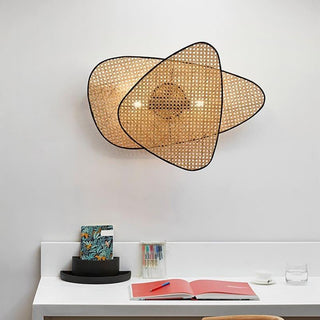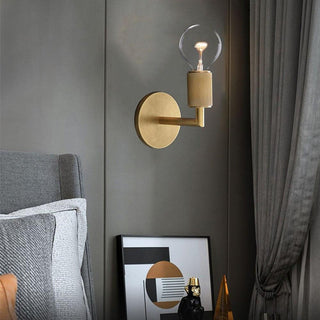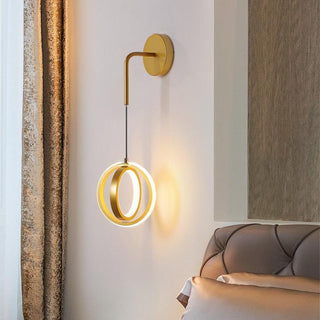Color temperature is a significant factor in how lighting affects our spaces, moods, and daily activities. Whether you’re relaxing in a living room or focusing in an office, understanding the basics of light temperature helps make the right choices for your home or workspace. Let’s dive into the color temperature scale, how it’s measured, and the ideal options for various rooms.
1. What is light color temperature?
1.1. Definition
Color temperature describes the appearance of light – specifically, how "warm" (yellow/red) or "cool" (blue/white) it looks.
You may have noticed that some lights, like candlelight, emit a soft, warm orange glow, while others, like midday sunlight, appear cooler and bluish. This "warm" or "cool" feeling isn't about the physical heat a lamp produces, but the color it expresses. Simply put, color temperature indicates whether a light source looks more yellow/orange or blue.
1.2. The science behind color temperature
Color temperature originates from the concept of a black body radiator, a theoretical model in physics. When this “black body” is heated, it emits light across a spectrum that shifts with temperature. As it gets hotter, the color changes from warm red to cool blue. This spectrum is expressed in Kelvin (K) degrees, where lower values indicate warmer tones and higher values reflect cooler tones.
In practical terms, light color temperature is correlated with the Kelvin scale, from around 1000K to over 6500K. Lower Kelvin values represent warm light sources like candlelight or incandescent lamps, while higher values indicate cooler lights like daylight or LED lighting.
2. The Kelvin scale in lightbulbs: ranges and meanings
2.1. How is light color temperature measured?
Color temperature is measured in Kelvin (K), a unit in physics. The Kelvin scale ranges from very warm (around 1000K) to very cool (up to 10,000K). Lower Kelvin numbers mean warmer, more yellow or orange light, while higher numbers mean cooler, more bluish light.
Think of it like this: a candle flame or incandescent lamp is on the warmer end, while natural daylight or bright LED lamps are cooler.
When buying a light bulb, you’ll usually see this Kelvin rating on the packaging, making it easier to choose the right type of illumination for your needs. The Kelvin number acts as a quick reference, helping you decide if the bulb will create a cozy, warm atmosphere or a bright, cool ambiance.
 light color temperature chart
light color temperature chart2.2. What color temperatures does each lightbulb type emit?
There is a general correspondence between the type of lightbulb and the color temperature it typically produces, though it’s important to note that with advancements in technology (especially for LEDs), the range of color temperatures available for each type of bulb has expanded. Here’s a summary of standard color temperatures by bulb type.
| Bulb Type | Typical Color Temperature (Kelvin) | Color Temperature Range | Common Uses |
|---|---|---|---|
| Incandescent | 2700K | Warm White | Ambient lighting in living rooms, bedrooms, and other residential areas where a cozy atmosphere is desired |
| Halogen | 2800K - 3000K | Warm to Soft White | Task lighting, bathrooms, and areas requiring accurate color rendering |
| LED | 2000K - 6500K+ | Wide range (Warm to Daylight) | Versatile for residential, commercial, and industrial applications, with options for color temperature adjustability |
| Fluorescent | 3000K - 6500K | Warm White to Daylight | Office buildings, commercial spaces, and some residential areas (e.g., kitchens, garages) |
| Metal halide | 4000K - 6500K | Cool White to Daylight | Industrial, outdoor, and large commercial spaces where high-intensity lighting is required |
Incandescent Bulbs
Traditional incandescent bulbs emit a warm, yellowish light with a color temperature around 2700K. This warm light creates a cozy, relaxing ambiance and is commonly used in living rooms and bedrooms.
Incandescents generally do not come in higher color temperatures, as their natural light output is warm.
Halogen Bulbs
Halogen bulbs produce a slightly warmer white light than incandescents, with color temperatures around 2800K to 3000K.
Halogens are often used in task lighting and places where accurate color rendering is important, as they have a high CRI. Like incandescents, they generally do not offer cooler color temperatures.
LED Bulbs
LEDs are highly versatile and can be manufactured to emit light across a wide range of color temperatures, from very warm (2000K) to very cool (6500K and above).
LEDs can also be color temperature adjustable, allowing users to change the light’s warmth or coolness to suit different settings. This flexibility makes LEDs suitable for almost any application, from residential to commercial to industrial lighting.
Fluorescent Bulbs
Fluorescent lights are available in a range of color temperatures, typically from 3000K (warm white) to 6500K (daylight).
They are commonly used in office and commercial settings, with cool white and daylight options being popular. However, some fluorescent bulbs have lower CRI, which can affect color accuracy.
Metal halide bulbs
Metal halide bulbs, commonly used in industrial and outdoor settings, emit a cool, bluish light typically in the 4000K to 6500K range.
They provide high-intensity lighting and are ideal for large spaces, though they may have lower CRI compared to halogen or LED options.
3. How does light color temperature affect a room?

Color temperature plays a significant role in a room’s mood and function. Warm light, like that from a 2700K bulb, creates a cozy and relaxing atmosphere, perfect for bedrooms and living spaces where you want to unwind. Cooler light, around 5000K, is better for concentration and productivity, making it ideal for workspaces and kitchens.
Each temperature range also impacts color perception. Under warm lighting, reds and yellows appear vibrant, while blues may seem muted. Cooler lighting enhances blues and greens, giving them a more vibrant and vivid appearance.
The perception of color temperature can also change based on dimming and surface reflection.
-
Dimming and color temperature
In traditional incandescent lighting, dimming usually creates a warmer, softer effect. LED lighting may not change color temperature when dimmed, but some adjustable LED lamps allow you to achieve a warmer tone with dimming. -
Surface colors and reflection
Warm-colored surfaces, like reds, yellows, and browns, reflect warm light effectively. Cooler walls, such as blues and greens, enhance cooler lighting, creating a balanced atmosphere.
4. Choosing the right color temperature for different spaces
Color temperature isn’t one-size-fits-all. Here are some proven tips to help you select the best lighting color for each room and application.
4.1. Rule of thumb for choosing color temperature
As a general rule, the more active you’ll be in a room, the cooler the light should be.
Cooler, blue-leaning light (like daylight) helps with focus, alertness, and productivity, mimicking natural sunlight that keeps us energized. For spaces where you’ll be winding down, warmer tones are better, as they provide a cozy and calming atmosphere, ideal for relaxation.
4.2. Color temperature choice by room
| Room | Color Temperature (Kelvin) | Temperature Name |
|---|---|---|
| Bedroom / Reading | 2700K - 3000K | Warm White |
| Living Room | 2700K - 3000K | Warm White |
| Bathroom | 4000K - 4500K | Neutral White |
| Kitchen | 3500K - 4500K | Neutral White |
| Office | 5000K | Cool White |
| Garage / Workshop | 5000K - 6500K | Daylight |
| Outdoor | 5000K - 6500K | Daylight |
Color temperature for bedrooms and reading nooks
Bedrooms are ideal for warmer lighting. Temperatures from 2700K to 3000K provide a comforting glow that’s perfect for winding down. Cooler blue light can disrupt sleep by suppressing melatonin, so low-blue, warm lighting supports a natural transition to rest.
Color temperature for living rooms
Like bedrooms, living rooms benefit from warm white light around 2700K to 3000K, creating a friendly and relaxing atmosphere for social gatherings or unwinding.
Color temperature for kitchens
A color temperature between 3500K and 4500K is ideal, offering enough brightness for food preparation. Kitchens with ample natural light may even benefit from daylight tones for an energetic, vibrant environment.
Color temperature for bathrooms
A neutral white light around 4000K to 4500K works well in bathrooms. This range provides clarity for grooming tasks while still offering a warm enough feel for relaxation.
Color temperature for offices
In offices, cooler lighting around 5000K mimics natural daylight, which is excellent for productivity, keeping workers alert without causing eye strain.
Color temperature for garages and workshops
For clarity and task lighting, cooler temperatures around 5000K or higher are preferred, as high Kelvin levels improve visibility, making them ideal for detail-oriented work.
Color temperature for outdoor lighting
Outdoor areas benefit from a mix of cool and daylight temperatures. Cooler light improves security, while warmer tones create a welcoming atmosphere.
4.3. Measuring and adjusting color temperature
To measure color temperature, use a light meter or refer to the Kelvin rating on bulb packaging. Color temperature adjustable LEDs are great for flexibility, allowing you to adapt the warmth or coolness of the light based on mood or time of day.
5. Color temperature in commercial spaces
5.1. Choosing color temperature for commercial settings
In commercial environments, the correct color temperature can improve productivity and ambiance. Cooler color temperatures, such as 5000K and above, are commonly used in office spaces to create an energizing, daylight-like environment.
Retail stores often opt for a mix of cool and neutral white to highlight products and enhance their color appearance. The lighting design in these spaces is calculated carefully to balance color, energy efficiency, and comfort for both employees and customers.
5.2. Examples of commercial lighting applications
- Offices: 5000K cool light to enhance focus and productivity.
- Retail Spaces: Neutral white with high CRI for accurate color representation.
- Warehouses: Daylight color temperature (6500K) for visibility and safety.
Conclusion
Understanding color temperature simplifies lighting selection. Choose warm white for a cozy atmosphere, neutral white for active spaces, and cool white for focused environments. Color temperature shapes both aesthetics and functionality, making it easier to set the right mood for any room.
Frequently asked questions
Does light color temperature affect sleep?
Yes. Blue light, common in cooler sources, can disrupt sleep. Warm light is better in the evening, as it aligns with our natural sleep cycle.
What’s the color temperature of an incandescent bulb?
Typically around 2700K, producing a warm glow suitable for relaxation.
Is there a difference between LED and fluorescent lighting temperatures?
Yes. LED lights offer a broader range of temperatures, while fluorescent lights generally lean towards cooler tones unless designed otherwise.
What color temperature is best for reading?
Warm white around 3000K is ideal for reading, offering comfortable brightness without strain.
Does color temperature affect room temperature?
No, color temperature is about appearance, not physical heat. A cool light isn’t necessarily cold, and a warm light isn’t necessarily hot. Color temperature only describes the appearance of light, not the actual heat emitted by the bulb.
What color temperature is the sun?
The sun's color temperature varies by time of day, atmospheric conditions, and location. Around noon, it’s approximately 5500K to 6500K, producing cool, bluish-white light. During sunrise or sunset, it drops to 2000K to 3000K, creating warm, reddish tones due to atmospheric filtering.



